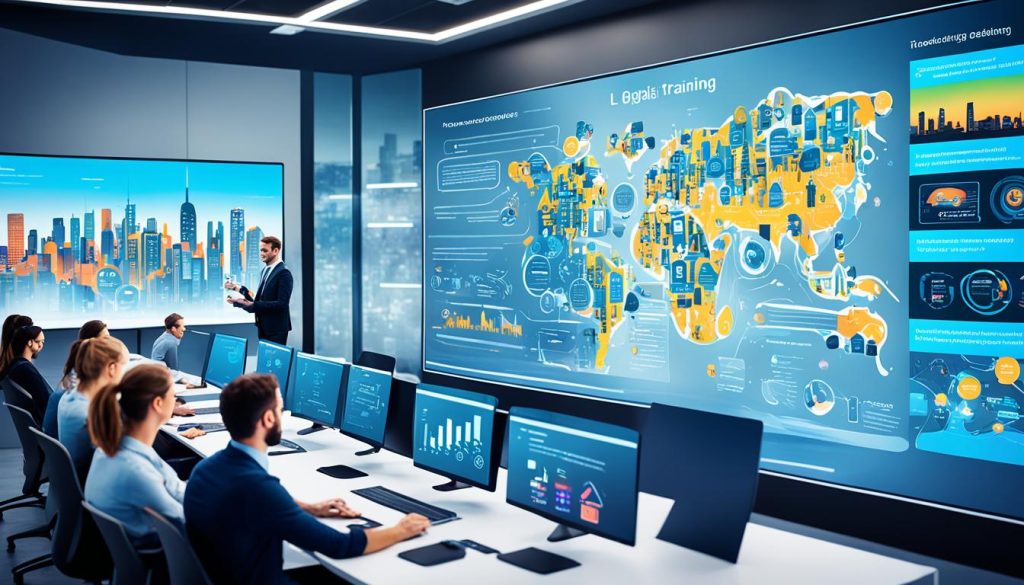Organizations recognize the value of continuous learning and development in today’s ever-changing business landscape. With advancements in technology, shifts in consumer behavior, and the impact of globalization, fostering a culture of continuous learning is imperative for staying competitive. A key aspect of enabling continuous learning is leveraging corporate e-learning platforms.
Key Takeaways:
- Continuous learning is vital in the dynamic workplace.
- Corporate e-learning platforms enhance the training experience.
- Embracing continuous learning leads to enhanced employee engagement and retention.
- Skills gaps can be addressed through regular assessments and tailored training programs.
- Technology, such as data analytics, empowers organizations to make data-driven decisions for future initiatives.
The Changing Dynamics Of The Workplace
Workplace dynamics are characterized by constant change. In today’s fast-paced business environment, organizations must adapt and evolve to stay competitive. One of the key factors that drive success in this ever-changing landscape is continuous learning. It is essential for employees to continually acquire new skills, update their knowledge, and stay ahead of industry trends. Continuous learning goes beyond the traditional onboarding process and plays a crucial role in enhancing workplace dynamics.
Continuous learning enables employees to navigate the dynamic landscape with ease. By investing in employee training and development, organizations empower their workforce to keep up with advancements in technology and industry trends. This enables employees to actively contribute to the growth and success of the organization.
Training should extend far beyond the initial onboarding process. Organizations should provide ongoing opportunities for employee training and development. This enables employees to acquire new skills, expand their knowledge base, and foster personal growth. Continuous learning promotes adaptability and helps employees stay relevant in an ever-evolving business environment.
“Continuous learning is the key to adaptability and growth in the workplace.”
By continuously investing in employee training and development, organizations create a competitive advantage for themselves. Companies that prioritize continuous learning foster a culture of innovation and proficiency. Employees who are encouraged to engage in continuous learning feel empowered and valued. They are more likely to contribute their best efforts and remain committed to their work.
To visualize the impact of continuous learning on workplace dynamics, refer to the table below:
| Benefits of Continuous Learning | Impact on Workplace Dynamics |
|---|---|
| Enhanced employee skills | Increased efficiency and productivity |
| Adaptability to technological advancements | Smooth transition and implementation of new technologies |
| Improved problem-solving abilities | Effective decision-making and creative solutions |
| Increased employee engagement | Positive work environment and higher retention rates |
By embracing continuous learning and providing opportunities for employee training and development, organizations can create a dynamic and adaptable workplace. This not only benefits the employees but also leads to organizational success in a rapidly changing business environment.
Fostering A Culture Of Continuous Learning
A culture of continuous learning is essential for organizations to thrive in today’s rapidly evolving business landscape. By creating an environment that values ongoing development and empowers employees, companies can cultivate a motivated and adaptable workforce. This section explores the importance of fostering a culture of continuous learning, emphasizing employee empowerment and professional development.
At the heart of a culture of continuous learning is the belief that acquiring new skills and knowledge is a lifelong journey. Organizations must encourage employees to embrace challenges, seek out learning opportunities, and take ownership of their professional growth. By doing so, companies can foster a sense of empowerment among their workforce, ensuring that employees feel valued and respected.
Training programs play a crucial role in supporting a culture of continuous learning. These programs should cater to the evolving needs of employees, addressing both current skill gaps and future industry trends. By investing in professional development initiatives, organizations demonstrate their commitment to the growth and success of their employees.
“Continuous learning is not just about attending a few training sessions; it is a mindset that empowers employees to proactively seek out new knowledge and skills.”
Furthermore, fostering a culture of continuous learning helps build a sense of loyalty and commitment among employees. When organizations prioritize employee development, individuals feel invested in the company’s future and are more likely to stay engaged and committed to their roles.
By embracing a culture of continuous learning, organizations can unlock the full potential of their employees. This leads to improved innovation, increased adaptability, and enhanced employee engagement and satisfaction.
To illustrate the impact of a culture of continuous learning, consider the following table:
| Benefits of a Culture of Continuous Learning | Description |
|---|---|
| Enhanced Employee Performance | Continuous learning improves employee skills, knowledge, and performance, driving overall productivity and efficiency. |
| Increased Employee Morale | By investing in employee development, organizations show that they value their employees, leading to higher levels of job satisfaction and motivation. |
| Improved Talent Retention | Employees who have access to continuous learning opportunities are more likely to stay with an organization, reducing turnover and retaining top talent. |
| Enhanced Organizational Agility | A culture of continuous learning equips employees with the skills and knowledge to adapt to changing market conditions and seize new opportunities. |
Investing in a culture of continuous learning is crucial for organizations seeking to stay competitive in today’s fast-paced business environment. By empowering employees, providing opportunities for professional development, and fostering a commitment to ongoing learning, companies can create a workforce that is adaptable, engaged, and ready to drive organizational success.

Addressing Skills Gaps
In today’s rapidly evolving business landscape, organizations face the challenge of skills gaps that hinder productivity and growth. To bridge these gaps, continuous training and development programs are crucial. By identifying the specific skills required for each role, organizations can tailor training programs to meet the needs of their employees.
Regular assessments play a vital role in identifying skills gaps and areas for improvement. These assessments enable organizations to understand the current capabilities of their workforce and determine where additional training is necessary.
This proactive approach helps enhance individual capabilities and overall competitiveness within the organization. By investing in skill development, employees are empowered to overcome challenges, adapt to changes, and contribute to organizational success.
Through targeted training programs, organizations can address the skills gaps effectively. These programs provide employees with the knowledge and skills needed to excel in their roles and contribute to the organization’s growth.
By continuously investing in employee capabilities, organizations can build a talented and skilled workforce that is equipped to navigate the ever-changing business landscape.

To illustrate the impact of addressing skills gaps, consider the following table:
| Skills Gap | Training Program | Employee Capabilities |
|---|---|---|
| Technical knowledge | Online courses and workshops | Up-to-date knowledge and expertise in relevant technologies |
| Communication skills | Communication workshops and role-playing exercises | Effective communication within teams and with clients |
| Leadership abilities | Leadership development programs and mentorship | Strong leadership capabilities and ability to inspire and motivate teams |
Case Study: XYZ Corporation
“At XYZ Corporation, we recognized the importance of addressing skills gaps to stay competitive in the market. We implemented a comprehensive training program tailored to our employees’ needs. Through assessments and feedback, we identified areas for improvement and designed training modules to enhance employee capabilities. As a result, our workforce became more skilled, adaptable, and productive. This investment in continuous learning has proven to be a game-changer for our organization.”
– Jane Smith, CEO of XYZ Corporation
Adopting Technological Solutions
Technology plays a pivotal role in enhancing employee training and development. Organizations worldwide are increasingly leveraging e-learning platforms, embracing flexible learning options, and harnessing the power of data analytics to optimize their training initiatives.

One of the key technological advancements in employee training is the emergence of e-learning platforms. These platforms provide a convenient and accessible way for employees to engage in training programs at their own pace and convenience. With a wide range of courses and modules available, employees can select the topics that align with their learning goals and job requirements, fostering a personalized learning experience.
Virtual simulations and mobile applications are also transforming the training landscape, offering employees interactive and engaging learning opportunities. Through virtual simulations, employees can practice real-life scenarios, improving their problem-solving and decision-making skills in a risk-free environment. Mobile applications enable employees to learn on the go, accessing training materials anytime and anywhere, making learning a seamless part of their daily routine.
“The integration of AI and data analytics into e-learning platforms allows organizations to provide personalized learning experiences based on individual employee needs and preferences.”
Artificial Intelligence (AI) and data analytics are revolutionizing employee training by providing actionable insights to optimize learning outcomes. By gathering and analyzing data on employee progress, organizations can identify areas of improvement and tailor training programs accordingly. This data-driven approach ensures that training initiatives have a measurable impact on employee performance and enhances the effectiveness of future training efforts.
Tracking Progress and Assessing Effectiveness
Data analytics enables organizations to track employee progress and assess the effectiveness of training programs accurately. Metrics such as completion rates, assessment scores, and task performance provide valuable insights into the effectiveness of the training initiatives. This data allows organizations to identify areas of improvement and make informed decisions to optimize training outcomes.
Furthermore, data analytics can help organizations identify trends and patterns in employee learning behavior. By understanding how employees engage with training materials, organizations can refine content, delivery methods, and learning pathways to boost employee engagement and knowledge retention.

Ultimately, adopting technological solutions like e-learning platforms, flexible learning options, and data analytics empowers organizations to create effective and engaging training programs that meet the ever-evolving needs of their workforce. By embracing these technological advancements, organizations can foster continuous learning and development, ensuring a skilled and agile workforce that drives organizational success.
Conclusion
Continuous training and development are essential in today’s dynamic workplace. In order to stay competitive, organizations must prioritize employee growth and empowerment through continuous learning. By providing employees with opportunities to acquire new skills and embrace challenges, organizations foster a culture of innovation and adaptability.
Creating a positive workplace culture that values continuous learning enhances employee engagement and retention. When employees feel supported and invested in, they are more likely to contribute to the organization’s success. Additionally, measurement and evaluation play a critical role in ensuring the effectiveness of training programs. By analyzing data and feedback, organizations can make informed decisions to improve and optimize future initiatives.
Commitment to continuous learning is a key driver of organizational success. As technology and industries rapidly evolve, investing in corporate training and continuous learning initiatives is crucial for staying ahead. Organizations that prioritize employee development not only enhance their capabilities but also position themselves for long-term growth and success in today’s competitive landscape.
FAQ
Why is continuous learning important for organizations?
How can organizations address skills gaps?
How can technology aid in employee training and development?
How can organizations foster a culture of continuous learning?
What are the benefits of continuous training and development?
Why is it important to prioritize employee growth?
Source Links
- https://elearningindustry.com/empowering-employees-through-continuous-training-and-development
- https://www.qooper.io/blog/corporate-learning
- https://www.linkedin.com/pulse/empowering-organizations-revolutionizing-corporate-learning-gasic-0pere?trk=article-ssr-frontend-pulse_more-articles_related-content-card




No comments! Be the first commenter?